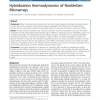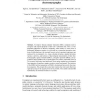1805 search results - page 95 / 361 » Modelling SIGNAL in Interaction Categories |
68
Voted
BMCBI
2010
14 years 10 months ago
2010
Background: While microarrays are the predominant method for gene expression profiling, probe signal variation is still an area of active research. Probe signal is sequence depend...
ECCV
2006
Springer
15 years 1 months ago
2006
Springer
To improve human-computer interaction (HCI), computers need to recognize and respond properly to their user's emotional state. This is a fundamental application of affective c...
109
Voted
APGV
2004
ACM
15 years 3 months ago
2004
ACM
Motivated by the need for an informative, unbiased and quantitative perceptual method for the development and evaluation of a talking head we are developing, we propose a new test...
HRI
2007
ACM
15 years 2 months ago
2007
ACM
Intelligent planning algorithms such as the Partially Observable Markov Decision Process (POMDP) have succeeded in dialog management applications [10, 11, 12] because of their rob...
HRI
2009
ACM
15 years 4 months ago
2009
ACM
During conversations, speakers establish their and others’ participant roles (who participates in the conversation and in what capacity)—or “footing” as termed by Goffman�...


